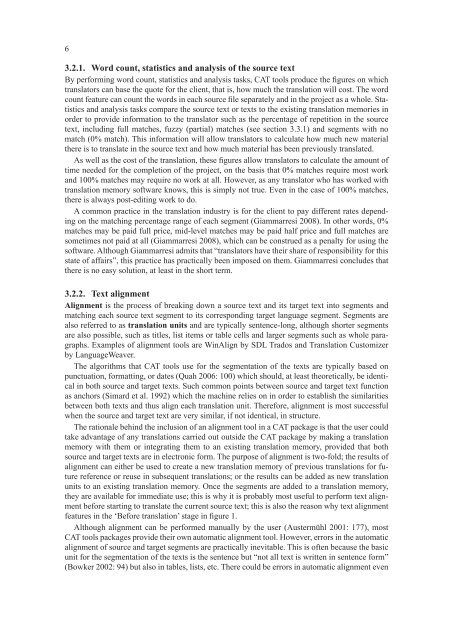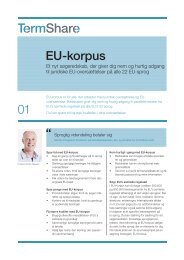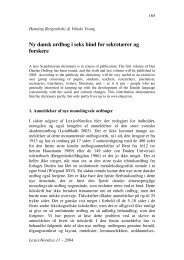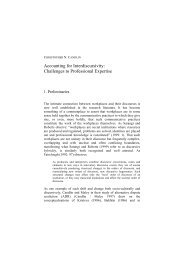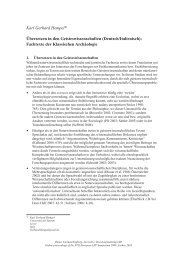The Workflow of Computer-Assisted Translation Tools in
The Workflow of Computer-Assisted Translation Tools in
The Workflow of Computer-Assisted Translation Tools in
You also want an ePaper? Increase the reach of your titles
YUMPU automatically turns print PDFs into web optimized ePapers that Google loves.
6<br />
3.2.1. Word count, statistics and analysis <strong>of</strong> the source text<br />
By perform<strong>in</strong>g word count, statistics and analysis tasks, CAT tools produce the fi gures on which<br />
translators can base the quote for the client, that is, how much the translation will cost. <strong>The</strong> word<br />
count feature can count the words <strong>in</strong> each source fi le separately and <strong>in</strong> the project as a whole. Statistics<br />
and analysis tasks compare the source text or texts to the exist<strong>in</strong>g translation memories <strong>in</strong><br />
order to provide <strong>in</strong>formation to the translator such as the percentage <strong>of</strong> repetition <strong>in</strong> the source<br />
text, <strong>in</strong>clud<strong>in</strong>g full matches, fuzzy (partial) matches (see section 3.3.1) and segments with no<br />
match (0% match). This <strong>in</strong>formation will allow translators to calculate how much new material<br />
there is to translate <strong>in</strong> the source text and how much material has been previously translated.<br />
As well as the cost <strong>of</strong> the translation, these fi gures allow translators to calculate the amount <strong>of</strong><br />
time needed for the completion <strong>of</strong> the project, on the basis that 0% matches require most work<br />
and 100% matches may require no work at all. However, as any translator who has worked with<br />
translation memory s<strong>of</strong>tware knows, this is simply not true. Even <strong>in</strong> the case <strong>of</strong> 100% matches,<br />
there is always post-edit<strong>in</strong>g work to do.<br />
A common practice <strong>in</strong> the translation <strong>in</strong>dustry is for the client to pay different rates depend<strong>in</strong>g<br />
on the match<strong>in</strong>g percentage range <strong>of</strong> each segment (Giammarresi 2008). In other words, 0%<br />
matches may be paid full price, mid-level matches may be paid half price and full matches are<br />
sometimes not paid at all (Giammarresi 2008), which can be construed as a penalty for us<strong>in</strong>g the<br />
s<strong>of</strong>tware. Although Giammarresi admits that “translators have their share <strong>of</strong> responsibility for this<br />
state <strong>of</strong> affairs”, this practice has practically been imposed on them. Giammarresi concludes that<br />
there is no easy solution, at least <strong>in</strong> the short term.<br />
3.2.2. Text alignment<br />
Alignment is the process <strong>of</strong> break<strong>in</strong>g down a source text and its target text <strong>in</strong>to segments and<br />
match<strong>in</strong>g each source text segment to its correspond<strong>in</strong>g target language segment. Segments are<br />
also referred to as translation units and are typically sentence-long, although shorter segments<br />
are also possible, such as titles, list items or table cells and larger segments such as whole paragraphs.<br />
Examples <strong>of</strong> alignment tools are W<strong>in</strong>Align by SDL Trados and <strong>Translation</strong> Customizer<br />
by LanguageWeaver.<br />
<strong>The</strong> algorithms that CAT tools use for the segmentation <strong>of</strong> the texts are typically based on<br />
punctuation, formatt<strong>in</strong>g, or dates (Quah 2006: 100) which should, at least theoretically, be identical<br />
<strong>in</strong> both source and target texts. Such common po<strong>in</strong>ts between source and target text function<br />
as anchors (Simard et al. 1992) which the mach<strong>in</strong>e relies on <strong>in</strong> order to establish the similarities<br />
between both texts and thus align each translation unit. <strong>The</strong>refore, alignment is most successful<br />
when the source and target text are very similar, if not identical, <strong>in</strong> structure.<br />
<strong>The</strong> rationale beh<strong>in</strong>d the <strong>in</strong>clusion <strong>of</strong> an alignment tool <strong>in</strong> a CAT package is that the user could<br />
take advantage <strong>of</strong> any translations carried out outside the CAT package by mak<strong>in</strong>g a translation<br />
memory with them or <strong>in</strong>tegrat<strong>in</strong>g them to an exist<strong>in</strong>g translation memory, provided that both<br />
source and target texts are <strong>in</strong> electronic form. <strong>The</strong> purpose <strong>of</strong> alignment is two-fold; the results <strong>of</strong><br />
alignment can either be used to create a new translation memory <strong>of</strong> previous translations for future<br />
reference or reuse <strong>in</strong> subsequent translations; or the results can be added as new translation<br />
units to an exist<strong>in</strong>g translation memory. Once the segments are added to a translation memory,<br />
they are available for immediate use; this is why it is probably most useful to perform text alignment<br />
before start<strong>in</strong>g to translate the current source text; this is also the reason why text alignment<br />
features <strong>in</strong> the ‘Before translation’ stage <strong>in</strong> fi gure 1.<br />
Although alignment can be performed manually by the user (Austermühl 2001: 177), most<br />
CAT tools packages provide their own automatic alignment tool. However, errors <strong>in</strong> the automatic<br />
alignment <strong>of</strong> source and target segments are practically <strong>in</strong>evitable. This is <strong>of</strong>ten because the basic<br />
unit for the segmentation <strong>of</strong> the texts is the sentence but “not all text is written <strong>in</strong> sentence form”<br />
(Bowker 2002: 94) but also <strong>in</strong> tables, lists, etc. <strong>The</strong>re could be errors <strong>in</strong> automatic alignment even


